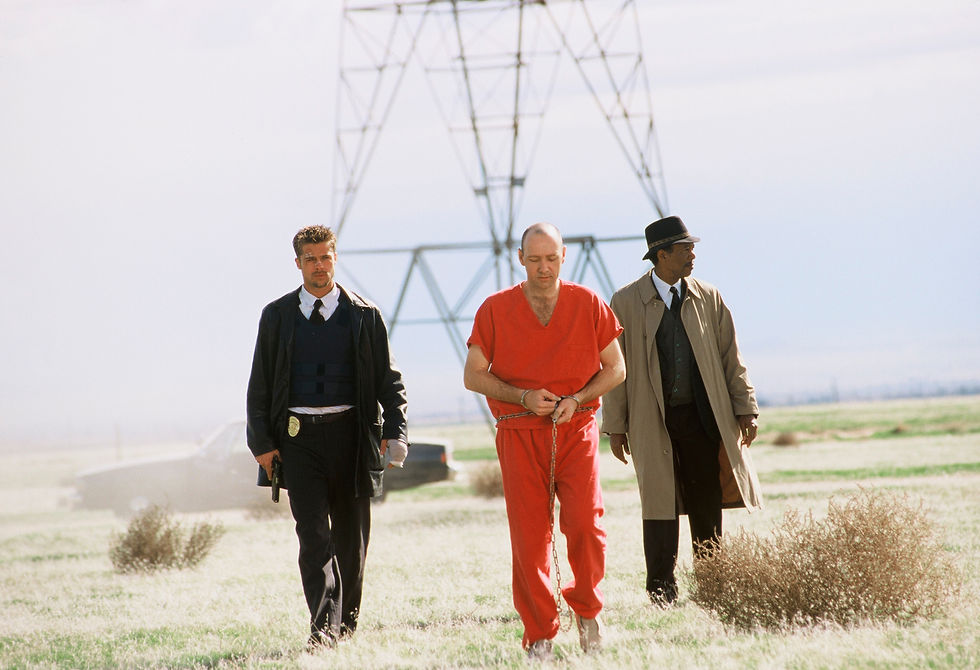Se7en (1995)
- Soames Inscker

- Jul 12
- 4 min read

In the grim corridors of neo-noir cinema, few films have cast as long and dark a shadow as David Fincher’s Se7en. Released in 1995, this bleak psychological thriller offered a jarring departure from conventional crime procedurals, replacing tidy resolutions with moral ambiguity, existential dread, and one of the most shocking endings in film history.
With outstanding performances, a haunting visual aesthetic, and masterful direction, Se7en is a disturbing, cerebral, and unforgettable descent into the heart of human depravity—and remains a modern classic nearly thirty years after its release.
Plot Overview
Set in a nameless, rain-drenched city, Se7en follows two detectives—seasoned, weary Detective William Somerset (Morgan Freeman) and hot-headed rookie Detective David Mills (Brad Pitt)—as they investigate a series of gruesome murders, each based on one of the seven deadly sins: gluttony, greed, sloth, lust, pride, envy, and wrath.
The killer, eventually revealed to be the eerily composed John Doe (Kevin Spacey), meticulously stages each crime as a form of moral punishment. His message: society is corrupt, indulgent, and deserving of judgment. As the detectives are drawn deeper into the case, they find themselves not only chasing a psychopath, but grappling with philosophical questions about justice, evil, and the fragility of human morality.
What begins as a grim manhunt spirals into a psychological nightmare—culminating in a now-infamous finale that leaves audiences shaken and silent.
Performances

Morgan Freeman delivers a career-best performance as Somerset, embodying quiet wisdom and a bone-deep weariness. His detective is not a hero in the traditional sense, but rather a man trying to impose meaning on a world he no longer believes in. Freeman’s narration and restraint give the film its emotional gravity.
Brad Pitt, as Mills, is all volatility and impulsiveness. His youthful idealism and rage contrast brilliantly with Freeman’s stoicism. Pitt captures the arc of a man unprepared for the darkness he faces, and the raw emotion he brings to the film’s final scenes is devastating.
Kevin Spacey (in a role revealed late in the film) is chilling as John Doe. His calm, articulate demeanor makes his character all the more disturbing. Spacey plays Doe not as a raving lunatic but as a deeply methodical, chillingly rational force—one who believes himself an agent of divine justice.
Gwyneth Paltrow, in a limited but essential role as Mills’ wife Tracy, provides the film’s sole note of innocence. Her performance is gentle and understated, making her fate all the more tragic.
Direction and Style

David Fincher, still recovering from his turbulent experience directing Alien 3, returned with a vengeance in Se7en. His direction is confident, uncompromising, and visually stunning. The film is soaked in perpetual rain and darkness, its unnamed urban landscape a reflection of moral decay and spiritual rot.
Fincher avoids jump scares in favour of slow-building dread. His use of low light, shadow, and industrial colour grading creates a suffocating atmosphere. Combined with Howard Shore’s brooding score and Darius Khondji’s oppressive cinematography, the world of Se7en is one of doom and decay, where hope barely flickers.
The film’s editing is taut, and the pacing deliberate—building toward the explosive finale without ever rushing. Fincher’s insistence on preserving the original ending, despite studio pushback, was a bold creative decision that cemented Se7en as an uncompromising work of art.
Themes and Symbolism
Se7en is more than a crime thriller—it’s a meditation on moral absolutism, urban alienation, and the inevitability of sin. John Doe is not merely a killer; he’s a self-styled preacher, a misanthropic prophet who sees the world’s apathy and cruelty as justification for his actions.
The deadly sins framework is not used as a gimmick, but as a structural backbone for a philosophical inquiry. Each crime scene becomes a commentary on human vice and societal failure. The film suggests that true evil may not be supernatural—it may simply be the result of unchecked apathy, pride, and righteous delusion.
The ending, in which Doe manipulates Mills into becoming an agent of wrath, transforms the killer’s plan into a self-fulfilling prophecy. It’s not merely a twist, but a gut-wrenching philosophical blow: by trying to fight evil, Mills becomes part of it.
Cultural Impact and Legacy
Se7en was both a critical and commercial success upon its release, earning over $300 million worldwide. Its influence has been vast, inspiring a wave of darker, more mature thrillers (The Bone Collector, Zodiac, True Detective) and setting a new standard for psychological horror in mainstream cinema.
Its final scene—set in a barren desert with the famous line “What’s in the box?”—has become an enduring moment in film history, shocking audiences and redefining the possibilities of genre storytelling. It is one of the most iconic and devastating climaxes ever committed to screen.
Conclusion
Se7en is a bleak, beautifully crafted masterpiece that challenges and disturbs in equal measure. It is a film about evil—not just the evil of one man, but of a world that fosters cruelty, indifference, and despair. Yet it is also about the last flickers of goodness—fragile, doomed perhaps, but still burning.
In the hands of lesser artists, this material could have become exploitative or pretentious. But with David Fincher’s assured vision, Andrew Kevin Walker’s razor-sharp script, and a flawless cast, Se7en becomes something rare: a thriller that lingers long after the credits roll, as much for its ideas as its horrors.
Rating:
Gripping, horrifying, and intellectually provocative—Se7en remains one of the most daring and unforgettable thrillers ever made.





